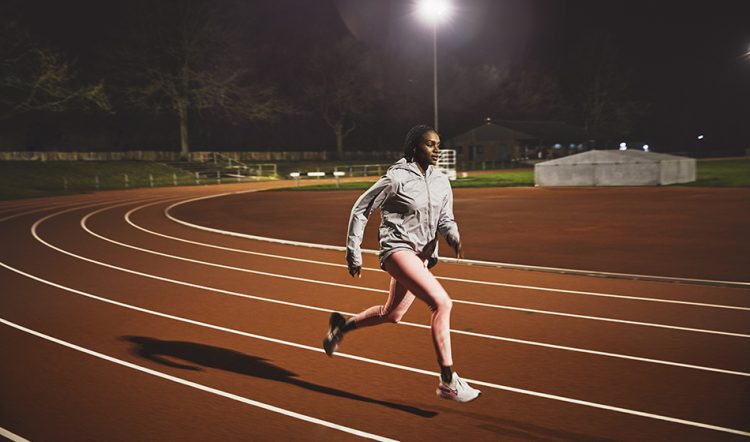World 200m champion explains how she ignores windy and wet weather in order to get the work done in pursuit of summer success
Dina Asher-Smith’s life has changed since she was crowned world champion in Doha in 2019. There are potentially more distractions as she is invited to more events and functions but the 24-year-old is keen to keep her feet on the ground ahead of the Tokyo Olympics.
She can still be found training on cold and damp winter nights alongside her Blackheath & Bromley colleagues and with her long-time coach John Blackie. “Training is the priority,” she says, “because I want to go into summer and be as fast as I can be.”
Q: Can you tell us about your training regime and your Instagram post, ‘What’s done in the winter will show up in the summer’?
Dina Asher-Smith: Quite simply, my coach John and I are firm believers in the philosophy of the work that’s done in the winter will show up in the summer. So, that just means when nobody’s watching, when it’s raining, when it’s maybe snowing, when it’s windy and wet and that’s when you’ve got to put in the work, because whatever you do in the winter months, whatever you do when it’s the winter training or the background season, directly translates to how well you run in the summer.

Q: What does your training regime look like at this time of year?
Asher-Smith: I train six days a week. I’m not on track every day, but I’m definitely doing something towards being faster and this time of year typically it’s lots of speed endurance, lots of high intensity runs and just focusing on getting stronger and getting faster and being the best athlete that I can be.
Q: Can you tell us about your goals for 2020?
Asher-Smith: My primary aim every single year is to stay injury free. At this time of year, I’m always thinking about the work I need to put in to get to the start line in the best possible shape. In order to do that, you need to have had a consistent training period.
Q: Can you describe a typical training day?
Asher-Smith: Every day is different. But obviously I train six days a week. The one day that I’m not training, I am sleeping or with my friends. If I’ve got gym, I will train in the gym from say 10 am – lots of hard work. It might be full of lots of coordination, stability, work. It might be strength, or power work at this time of year. Then I’ll eat, I’ll go home, relax a bit, do some work on my laptop or do some work if I’ve got a meeting or focus on the business stuff in the middle of the day. Then I start my training at 6:30pm. So, I’ll see my physio to get my preparation work done, warm up for about an hour, do the session, warm down for like half an hour, 40 minutes, including a massage and then eat, chill, sleep, do it all again.
Q: You’re using the new React Infinity Run?
Asher-Smith: Everybody wants to get to the start line feeling fit and fast. Nobody wants any interruptions in their lead up. I wore the original Epic Reacts – and the new React Infinity Run trainers are a fantastic next step. I particularly like the smooth ride and the improved cushioning, which is important if you’re running regularly. They’re designed to help reduce injury and keep you on the run which is important for me as it’s all about being fit and fast for Tokyo.
» For more athlete insight, read the training special in the January 30 issue of AW magazine, which includes interviews with Holly Bradshaw, Andy Butchart, Sophie McKinna, Nethaneel Mitchell-Blake, Jamie Webb, Steph Twell and Tom Evans














